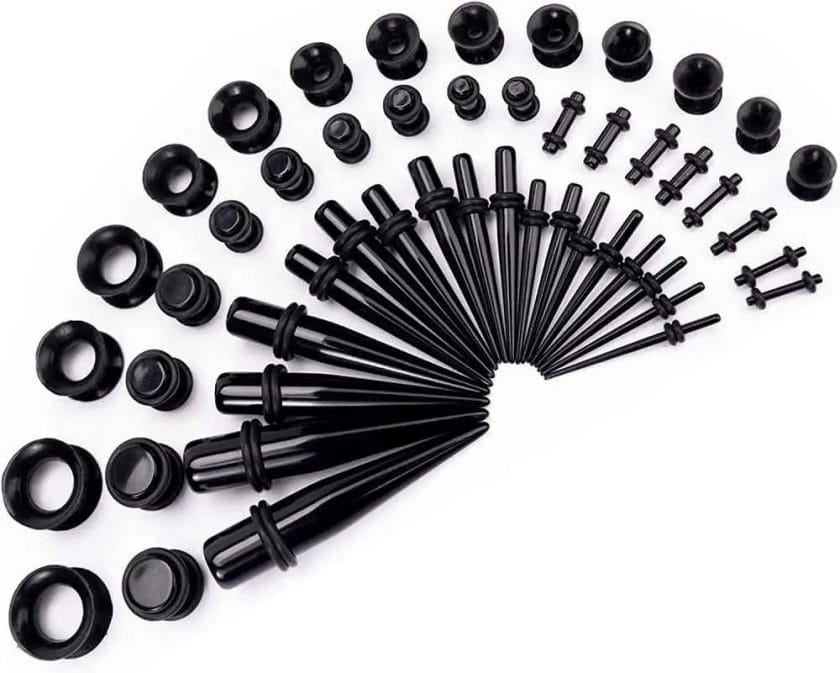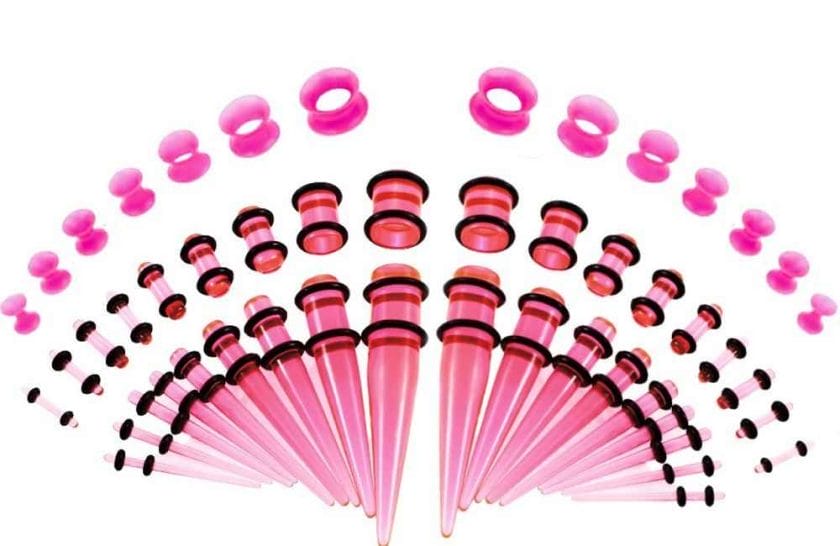Acrylic tapers are a popular choice among body jewelry enthusiasts for stretching earlobes, among other uses. However, there isn’t a way to sterilize acrylic tapers, which makes one wonder if they are safe to use.
In this article, we will provide a comprehensive overview of acrylic tapers, covering their safety concerns, and whether they are safe to use or not.
What are Acrylic Tapers?
Acrylic tapers are ear stretching tools made of a lightweight, synthetic material called acrylic. They come in a variety of shapes, sizes, and colors and are used to gradually stretch the earlobe to accommodate larger-gauge jewelry.
Composition and Design
Acrylic is a type of plastic that is known for its durability, resistance to bacteria and fungi, and easy-to-clean surface. This makes it a popular choice for body jewelry that is inserted into the skin.
In terms of design, acrylic tapers come in many different shapes and colors. Some are simple, straight tubes, while others are more elaborate and feature unique designs or patterns.
Size and Shape
When it comes to ear stretching, size is everything. Acrylic tapers are available in a range of sizes to accommodate different stretching goals.
As a general rule, it is recommended to start with a small gauge and gradually increase the size over time to allow the earlobe to adjust.
In terms of shape, tapers are either straight or tapered. Straight tapers are used to stretch the earlobe in a gradual and consistent manner, while tapered tapers are used to more quickly and effectively stretch the earlobe to a larger size.
Are Acrylic Tapers Safe?
Acrylic tapers are used for stretching and are the most affordable material. However, there is no way to properly sterilize them, so acrylic tapers carry a higher risk of holding or transferring bacteria.
Also, the ears secrete a liquid that may eventually break down the acrylic taper and irritate your ears.
Benefits of Acrylic Tapers
There are several benefits to using acrylic tapers for ear stretching, including:
Lightweight and Easy to Handle:
Compared to other materials such as metal or stone, acrylic is lightweight and easy to handle, making it a popular choice for those who are just starting to stretch their ears.
Durability and Long-lasting:
Acrylic is a durable material that can withstand daily wear and tear, making it a long-lasting choice for body jewelry.
Easy to Clean and Maintain:
Acrylic is easy to clean and maintain, which is important when it comes to body jewelry that is inserted into the skin. Simply wiping down the surface with a mild soap and water is enough to keep it looking new.
Safe for All Skin Types:
Unlike some materials, acrylic is hypoallergenic and safe for all skin types. This makes it a good choice for those with sensitive skin who are looking to stretch their ears.
Safety Concerns
While acrylic tapers have several benefits, it is important to be aware of potential safety concerns and take appropriate precautions when using them.
Quality of the Product:
When choosing an acrylic taper, it is important to make sure that the product is of high quality and free of defects. Poor quality tapers can break or cause injury, so it is essential to choose a reputable brand.
Proper Insertion:
It is also important to insert acrylic tapers correctly to minimize the risk of injury. This involves gently inserting the taper into the earlobe, twisting it a little, and then slowly and carefully pushing it through.
Risk of Infection:
As with any type of body jewelry, there is a risk of infection when using acrylic tapers. This can be prevented by making sure that the taper and earlobe are clean and dry before insertion and by avoiding touching the ear with dirty hands.

Prevention and Care Tips:
To reduce the risk of infection and other complications, it is important to follow proper aftercare and maintenance procedures.
This includes cleaning the taper and earlobe regularly, avoiding harsh chemicals and excessive manipulation, and seeking medical attention if there are any signs of infection.
How to Choose the Right Acrylic Taper
With so many options available, choosing the right acrylic taper can be overwhelming. Here are some tips to help you select the right one for you:
Select the Right Size:
Start with a small gauge and gradually increase the size over time to allow your earlobe to adjust. It is important to not go too big too quickly, as this can cause pain and even permanent damage.
Design and Color Considerations:
Acrylic tapers come in many different designs and colors. Consider your personal style and preferences when selecting a taper.
Quality Control and Brand Reputation:
Make sure to choose a reputable brand that is known for producing high-quality products. Read reviews and ask for recommendations from trusted sources to ensure that you are getting a safe and reliable product.
Seeking Advice from Professionals:
If you are new to ear stretching or have any concerns, consider seeking advice from a professional piercer or other trusted expert. They can provide valuable insights and help ensure that you are using the right taper for your needs.

Conclusion
Acrylic tapers are a popular and convenient choice for ear stretching. They are lightweight, durable, easy to clean, and safe for all skin types.
However, it is important to be aware of potential safety concerns and take appropriate precautions, such as choosing the right size, selecting a reputable brand, and seeking advice from professionals.
By following these tips, you can enjoy the benefits of acrylic tapers while minimizing the risk of injury or infection.
What is the maximum size that I can use an acrylic taper for ear stretching?
It is recommended to start with a small gauge and gradually increase the size over time to allow your earlobe to adjust.
The maximum size that you can use an acrylic taper for ear stretching will depend on several factors, including the thickness of your earlobe and your personal comfort level.
It is important to not go too big too quickly, as this can cause pain and even permanent damage.
How long does it take to stretch my ears with acrylic tapers?
The length of time it takes to stretch your ears with acrylic tapers will depend on several factors, including the gauge you start with, the size you are aiming for, and your body’s natural rate of healing.
Generally, it is recommended to wait at least 4-6 weeks between stretches to allow your earlobe to fully heal and adjust.
Are there any side effects of using acrylic tapers for ear stretching?
Some people may experience mild discomfort or soreness when using acrylic tapers for ear stretching, especially when stretching to larger sizes. This is normal and should subside within a few days.
However, if you experience any redness, swelling, or pain that lasts for more than a few days, it is important to seek medical attention as it could be a sign of infection.
Is it safe to sleep with acrylic tapers in my ears?
It is generally not recommended to sleep with any type of body jewelry, including acrylic tapers, in your ears.
This is because movement during sleep can cause irritation and increase the risk of infection or injury. It is best to remove your tapers before sleeping and reinsert them in the morning.
Can I use acrylic tapers for other types of ear stretching, such as stretching to an ear gauge?
Acrylic tapers are designed specifically for stretching earlobes and are not recommended for other types of ear stretching, such as stretching to an ear gauge.
For this type of stretching, it is best to seek advice from a professional piercer and use the appropriate jewelry, such as ear gauges or flesh tunnels.
